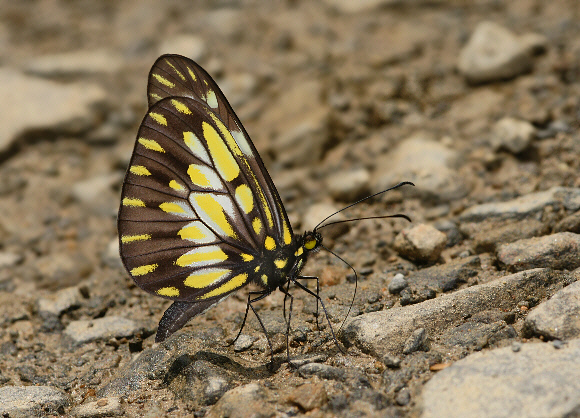
Introduction
The subfamily Dismorphiinae, to which the Wood Whites of Europe belong, has its headquarters in South America, where 51 different species are found. The neotropical genera include Dismorphia, Enantia, Lieinix, Patia, Moschoneura, and Pseudopieris.
The 30 species in the genus Dismorphia are characterized by having long narrow almost elliptical fore-wings, and disproportionately large hindwings.
All Dismorphia species are mimics, and in some cases the males and females mimic different species – e.g. the male of Dismorphia laja is black with cream bands and appears to be a mimic of Heliconius wallacei, while the female is patterned in orange, yellow, and black, and mimics “tiger-complex” Ithomiines. In the case of Dismorphia theucharila both sexes are extremely convincing mimics of glasswing Ithomiines, and no doubt gain a high degree of protection from predators by resembling these toxic and unpalatable butterflies. It is the Dismorphiine butterflies which inspired the great 19th-century naturalist Henry Walter Bates to propose his theory of mimicry, now known as Batesian mimicry.
Dismorphia lygdamis is unusual in that it appears to be a mimic of Catasticta sinapina – another Pierid butterfly, albeit in a different subfamily – Pierinae. Both species are inhabitants of the cloud forests of the Peruvian Andes.
Habitats
This species is found in cloud forest and pre-montane habitats at altitudes between about 600-1500m.
Lifecycle
Unknown, however DeVries states that several Dismorphia species in Costa Rica feed as larvae on Inga or Pithecellobium ( Mimosaceae ). In the case of most species in the subfamily Dismorphiinae, the eggs are spindle-shaped, and laid singly on the underside of leaves. In most ( probably all ) species the larvae are cryptically colored – dark green above, and paler green below.
Adult behaviour
Males are usually found in the vicinity of small waterfalls and rivulets, where they imbibe mineralized moisture from rocks or road surfaces. It is not uncommon to find Catasticta species drinking at the same places.
Both sexes visit flowers including Eupatorium for nectar.
